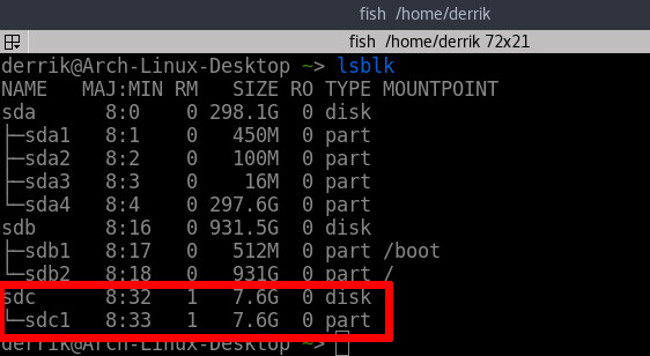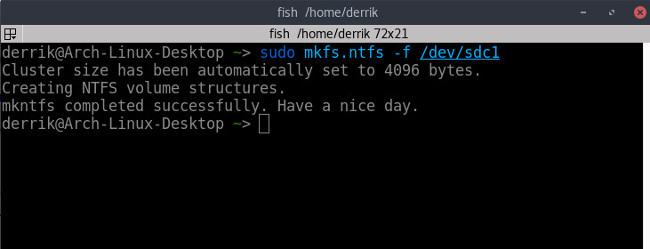This is how to 'recover' a failed USB drive on Linux
Often users use USB drives to store data securely. However in some cases the USB drive may be faulty or simply not work. If you are using a Linux operating system and you have a similar error on the USB drive, then you can use the commands to restore the USB drive.
 This is how to 'recover' a failed USB drive on Linux Picture 1
This is how to 'recover' a failed USB drive on Linux Picture 1
1. Remove the error files on the USB drive with fsck
The easiest way to recover a USB drive is to use the fsck tool. This is a great tool for removing corrupted files, and often these error files are the cause of the error.
To remove the error files on the USB drive, first open the terminal window and then enter the following command into: Lsblk
Note :
The user must find out what the USB drive name is on the system before proceeding. To do this enter the lsblk command, and the command will list all the drives on your system.
The lsblk command will list all the drives on the system, not just the USB drive, so you need to pay attention to output so that you don't mistake the hard drive name for the USB drive.
 This is how to 'recover' a failed USB drive on Linux Picture 2
This is how to 'recover' a failed USB drive on Linux Picture 2
To remove all corrupted files, run the fsck command on a specific partition (for example, / dev / sdc1) or on the entire drive (eg / dev / sdc).
Once completed, the USB drive will partition new and work on Linux: sudo fsck / dev / sdc1
Note :
In this example, assume the USB drive is / dev / sdc (or / dev / sdc1). Users can use other names for their USB drives on the system.
 This is how to 'recover' a failed USB drive on Linux Picture 3
This is how to 'recover' a failed USB drive on Linux Picture 3
2. Completely "clean" the USB drive
Sometimes the USB drive may not be able to read the data stored in it. If this happens, it is best to adjust the data to 'zero' and start again. The best tool to use in this case is dd .
First find the USB drive name using the lsblk command ( note that / dev / sdc1 is a partition and / dev / sdc is the entire device ).
sudo dd if = / dev / zero of = / dev / sdc
3. Create a new system file
 This is how to 'recover' a failed USB drive on Linux Picture 4
This is how to 'recover' a failed USB drive on Linux Picture 4
After cleaning up the USB drive, the data on it will be completely useless, no longer valid. This means you will have to create a new data partition. Select a system file and run the command:
- Fat32:
- sudo mkfs.msdos -f 32 / dev / sdc1
- Ext4:
- sudo mkfs.ext4 -f / dev / sdc1
- NTFS:
- sudo mkfs.ntfs -f / dev / sdc1
Refer to some more articles below:
- Protect your Google account with USB "security key"
- Summary of some ways to fix USB Device Not Recognized on Windows 7, 8 and 10
- Want to know if your computer supports USB 3.0, read this article
Good luck!
You should read it
- Summary of some ways to fix USB Device Not Recognized on Windows 7, 8 and 10
- 6 ways to fix the error of not recognizing SSD drive in Windows 10
- Instructions for fixing errors 'not recognized as an internal or external command' when using CMD in Windows
- How to fix VPN error 619
- How to fix A20 Error when starting the computer
- How to fix USB device not recognized error on Windows
- Details on how to effectively fix USB Device Not Recognized Windows 11 error
- Instructions on how to fix 53 error when restoring on iPhone
- Instructions for fixing device Usb error not recognized Code 43
- Fix error 3014 while restoring iPhone
- How to fix 'This App Can't Run on Your PC' error on Windows 10
- 6 ways to fix Bluetooth errors not in Device Manager on Windows 10, 8.1, 8, 7, XP, Vista
May be interested

Instructions to disable Root account on Linux

Display IP address on the system tray on Ubuntu

Running Linux on Windows 10 does not require a virtual machine, here are 18 things you should know

Which Linux distros will Windows 10 put into Windows 10?

5 best remote desktop applications for Linux to access remote computers

How to create a Custom Kernel on Ubuntu






 How to recover deleted files on Linux
How to recover deleted files on Linux How to use Foremost to recover deleted files in Linux
How to use Foremost to recover deleted files in Linux How to recover data from 'Ghost' (or image) error-free hard drive
How to recover data from 'Ghost' (or image) error-free hard drive How to clean and recover space on C drive Windows 10
How to clean and recover space on C drive Windows 10 Full list of Google Drive clients for Linux
Full list of Google Drive clients for Linux How to Boot Linux from USB on Windows 10
How to Boot Linux from USB on Windows 10